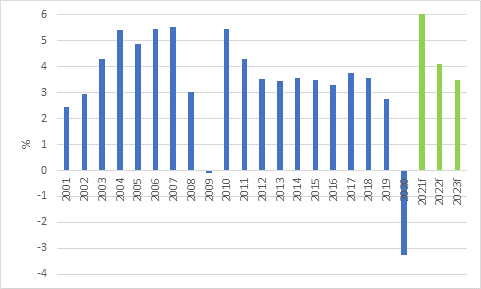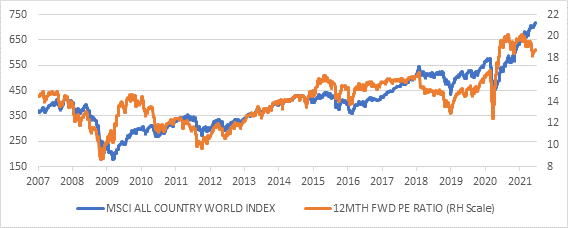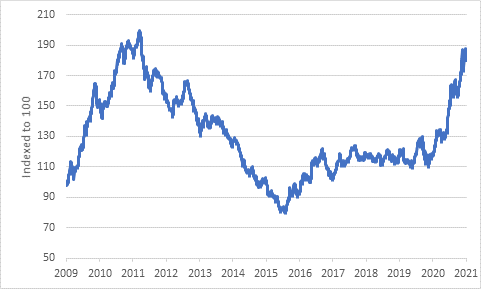Old Mutual Wealth Investment Strategists Izak Odendaal and Dave Mohr

Izak 
DAve
After several decades of calm, the global economy was hit by two massive crises in the space of 12 years: the 2008 Global Financial Crisis (GFC), and Covid-19.
As the world now exits the pandemic (unevenly), it is worth comparing this recovery phase with the early post-financial crisis period. One could of course write a whole book about it, so in the interest of brevity, the focus is on four areas: economics, policy, investor behaviour and a few thoughts on South Africa’s specific experience.
Recoveries, fast and slow
Starting with economics, it is important to highlight that the two crises had very different origins. The financial crisis followed years of strong growth that resulted in the build-up of major imbalances, notably household debt tied to a property. While the GFC is often blamed on the collapse of Lehman Brothers in September 2008, in reality the entire global financial system and global economy were dangerously unbalanced, and any number of events could have set off a collapse.
The global recovery was unexpectedly strong in 2010, with IMF data showing a 5.3% bounce following the 0.1% contraction in 2009. But the scars of the financial crisis meant the subsequent years saw disappointingly tepid global economic growth. Though interest rates fell to unimaginably low levels, households across the rich world did not want to borrow more. They were still paying off debts related to properties whose values had declined. At any rate, banks did not want to lend much either. They were also busy repairing balance sheets after the near-death experience of the crisis, with regulators also pushing for much tougher capital buffers.
The pandemic, in contrast, was an exogenous (external) shock, like a natural disaster. It stands to reason that the recovery should be quicker. Once people are no longer scared of getting the virus, they will want life to return to normal. That is, for those who are financially able to do so. Though unemployment has declined, it remains elevated. Nonetheless, though the 2020 recession was much deeper than 2008 for most countries, it was shorter with the recovery phase coming much sooner.
The latest round of purchasing managers’ indices for June are at very robust levels. The composite PMI (services and manufacturing) for the US was at 63.7, with levels above 50 indicating expansion. The Eurozone PMI hit a 15-year high of 59.2. This suggests the global economy can achieve the IMF’s forecasts for 6% growth this year, following the record 3.2% decline in 2020.
Chart 1: Real global economic growth with forecast, %

Source: International Monetary Fund
New normal?
Having said that, the definition of ‘normal’ has changed for many. Remote working has proven to be a workable alternative, and this has contributed to a housing boom in many countries. This clearly contrasts to the post-2008 period, where property markets spent many years in the doldrums, weighed down by oversupply. Indeed, the last decade saw the housing supply grow very slowly. Now that demand has shot up, many buyers are struggling to find what they are looking for in the suburbs.
Apart from remote working, the pace of technological adoption seems to have sped up more broadly. This may give a positive boost to productivity and counter the impact of slowing population growth in many developed countries. If not, we should not expect the current boomy growth rates to last (long-term economic growth is basically the combination of growth in the workforce and productivity growth).
Policy predicaments
The financial crisis forced policymakers to reach for unorthodox tools. Central banks slashed rates to zero, hitting the so-called lower bound, and thereafter turned to quantitative easing (buying bonds) to improve liquidity and ease financial conditions. This worked to end the acute phase of the crisis but did not help the recovery much. Again, low interest rates are less effective if no one wants to borrow. The fiscal policy response was largely aimed at bailing out banks. Nonetheless, government debt levels shot up, particularly in developed countries. In China, an epic credit boom was unleashed at the government’s direction (but not through direct government funding).
This world of ultra-loose monetary policy and high government debt levels soon gave rise to cries from certain corners of ‘currency debasement’ that would lead to hyperinflation. The emphasis soon turned to ways of reducing government debt. In 2010, the UK’s coalition government announced its intentions to balance the books by cutting spending.
By 2011, several southern European countries faced a full-blown fiscal crisis, with Greece eventually needing bailouts but also having deep budget cuts imposed. The US also took a sharp turn to austerity in 2013. Much was said about the ‘bond vigilantes’ who would punish governments for not tackling debt, but in reality, the bond markets of the major economies (Germany, UK, US but not Italy or Spain) were practically begging the major economies to borrow more. There was an overwhelming demand for their bonds as indicated by low bond yields.
Much like today, there was an inflation scare, largely due to commodity prices recovering quickly. While some central banks, notably the US Federal Reserve and the Bank of England, correctly looked through the temporary spike in inflation, others panicked. The European Central Bank hiked rates in 2011 even as the region was about to be engulfed by the debt crisis. It must rank as one of the worst policy errors on record. It was eventually forced to cut rates into negative territory (unthinkable a decade ago), and they have remained submerged ever since.
Policymakers have taken some of these lessons on board. On the fiscal side, the advice from the IMF, traditionally the high priests of fiscal discipline, has been to focus on economic recovery, not debt levels. The US in particular opened up the spending taps. The Trump and Biden administrations borrowed trillions (with at) to prop up the economy in the wake of Covid-19. More are in the pipeline, with agreement on an $1 trillion infrastructure deal seemingly reached last week.
In terms of monetary policy, the focus over the past two weeks has been on the slight shift in the Fed’s outlook for interest rates in its recent meeting. But broadly speaking, the Fed still maintains that rates will remain very low (and negative in real terms) for several years. And while it will eventually start to slow or taper its monthly bond buying programme, maybe later this year even, it’s likely to still be active in the bond market well into 2022. Selling the bonds back into the market, quantitative tightening is a very distant prospect.
For the Fed in particular, the lessons came not only from looking through the inevitable distortions of the early post-GFC days but also from the last days of the pre-pandemic era. In 2019, unemployment had fallen to near-record lows, wage growth was finally accelerating, and thousands of marginalised workers were being pulled into the labour markets without any sign of inflation. This seems to have convinced Powell and the company of the benefits of letting the economy run and to not try to attack inflation pre-emptively.
Market behaviour
Global equity markets suffered horrific losses throughout 2008 and into early 2009. Peak to trough, the MSCI All Country World Index lost 58%. It bottomed out on 9 March 2009, and then staged an impressive rally even though the global economy was still in bad shape as described above. The US, Eurozone and Japanese economies were still contracting, but investors realised the worst was over (particularly after the stress tests showed that banks were in better shape). The rally was rapid, and the global equities doubled in the space of 18 months.
Many commentators thought it was too much too soon. Over the subsequent years, it became known as the most unloved bull market. Investors were continuously looking over their shoulders, worried that a repeat of 2008 loomed. There were three serious pull-backs in 2011, 2015 and 2018, but over the period from 2009 to 2019, global equities delivered 14% annualised or 334% in total. Not bad.
With hindsight, one reason for this performance is that equities were cheap by historic standards when the rally started in 2009. The forward PE ratio was 10. The other is that bond yields steadily declined over the decade, making equities more attractive by comparison. Thirdly, much of the gains can be attributed to a handful of superstar technology companies.
Chart 2: Global equity returns and valuation

Source: Refinitiv Datastream
Looking ahead, bond yields have limited room to fall further, and while another company can emerge to post Amazon or Apple-like growth rates, it is not a given. But the biggest worry for global investors today is valuations. As investors realised that worst-case scenarios would not come to pass, the equity market bottomed out in March 2020 and rallied at a blistering pace (even faster than in 2009). While company profits are rebounding, the forward price earnings ratio remains elevated at 18. Global equities can still deliver positive real returns in the coming years, and the asset class is definitely more attractive than developed market cash or bonds. But we will probably have to settle for lower returns than over the previous decade.
In 2008 and 2020, the rand fell sharply as equity markets crashed and investors fled to the safety of the US dollar. In both cases, the rand retraced most of its losses over the next year once the panic had subsided. Despite it being a familiar pattern, it still caught many by surprise.
South Africa’s cycles
The early post-GFC era was a time of optimism in South Africa. We had a mild recession by global standards, our banks survived unscathed, commodity prices quickly rebounded, and the 2010 FIFA World Cup was a successful showcase of the country’s beauty and brains. It wasn’t to last.
Commodity prices peaked in 2011 and would collapse over the next four years. Though demand from China slowed somewhat, the big reason was a surge in supply as new mines that were commissioned during the boom years started coming on stream.
Chart 3: Index of US dollar prices of South Africa’s main commodity exports

Source: Refinitiv Datastream
A large current account deficit earned us a spot in the Fragile Five and would leave us dependent on volatile capital flows. This in turn contributed to the Reserve Bank hiking interest rates in early 2014 even as domestic growth was slowing down. And a country once known for stable and sensible policies introduced the terms ‘Nenegate’, ‘Nkandla’ and ‘State Capture’ to its lexicon, along with the slightly older ‘load-shedding’. The government’s fiscal deficits ballooned. Unlike in developed countries, the government borrows at high real interest rates. The unambiguous signal from the market is to stabilise the debt.
In other words, South Africa came into the pandemic in bad shape. It is hard to imagine being hit by a worse crisis, and while a third wave is still raging (and rising), it is important to note that the economy did not collapse and society did not disintegrate
The economic recovery seems to be going better than expected. The announced move back to Level 4 restrictions for two weeks will hit the hospitality sector hard, but depending on how long it lasts, the damage is likely to be contained. We are helped by elevated commodity prices, and while the post-GFC experience suggests we shouldn’t bank on the good times lasting forever, so far there is there is little indication of a notable supply increase that could sink prices.
Inflation is under control. Though last week’s CPI data shows a jump in headline inflation to 5.2% year-on-year in May, this largely reflects the rebound in oil prices from a year ago in a pattern very similar to 2010. Core inflation, which excludes volatile food and fuel prices, was only 3.1%. A muted inflation outlook means the Reserve Bank can keep interest rates close to current levels for some time, given the economy the support it needs.
Importantly, we seemed to have turned the corner on the policy side. The government has reiterated its commitment to fiscal consolidation, though the market will only believe this fully once a wage deal is inked with public sector unions. The last few weeks have seen a number of structural economic reforms announced, most recently an adjustment in how the country’s underperforming ports are run, which among other things will allow for private sector investment. President Ramaphosa’s consensus-driven approach has been heavily criticised for being slow, but the reforms are more likely to stick and outlive his tenure if there is broad buy-in.
Learning the lessons
The next decade is not going to follow the same path as the previous one, but there is a lot we can learn. There are four points to highlight in closing. Firstly, such a disruptive experience will leave a lasting psychological imprint on many people, particularly those who entered adulthood (and hence financial responsibility) for the first time. An entire generation could end up with very different attitudes to work, money and risk. How exactly, only time will tell.
Secondly, policymakers have learned lessons too, but they cannot control everything. There will be surprises and there will be market wobbles. However, life goes on and investors should avoid panicking. Even the political earthquakes of 2016, the Brexit vote and Trump’s surprise win, ended up doing less portfolio damage than feared.
Thirdly, the pandemic was an exogenous shock, a true black swan event. But for the most part, markets and economies are cyclical. Things that go up (relatively speaking), eventually go down and vice versa. Be careful of confusing a cyclical change with a permanent shift. South Africa went through a bad cycle, and now it seems that the cycle has turned.
Finally, the bull market of 2009 to 2019 was born in doubt and raised in fear. Talk of a ‘low return environment’ abounded. And yet the best course of action was just to hold your nose and invest, without trying to be clever about timing. Those who waited for clarity and certainty – or the next pull-back – missed out.


